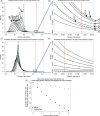The implications of small stem cell niche sizes and the distribution of fitness effects of new mutations in aging and tumorigenesis
- PMID: 27099622
- PMCID: PMC4831459
- DOI: 10.1111/eva.12361
The implications of small stem cell niche sizes and the distribution of fitness effects of new mutations in aging and tumorigenesis
Abstract
Somatic tissue evolves over a vertebrate's lifetime due to the accumulation of mutations in stem cell populations. Mutations may alter cellular fitness and contribute to tumorigenesis or aging. The distribution of mutational effects within somatic cells is not known. Given the unique regulatory regime of somatic cell division, we hypothesize that mutational effects in somatic tissue fall into a different framework than whole organisms; one in which there are more mutations of large effect. Through simulation analysis, we investigate the fit of tumor incidence curves generated using exponential and power-law distributions of fitness effects (DFE) to known tumorigenesis incidence. Modeling considerations include the architecture of stem cell populations, that is, a large number of very small populations, and mutations that do and do not fix neutrally in the stem cell niche. We find that the typically quantified DFE in whole organisms is sufficient to explain tumorigenesis incidence. Further, deleterious mutations are predicted to accumulate via genetic drift, resulting in reduced tissue maintenance. Thus, despite there being a large number of stem cells throughout the intestine, its compartmental architecture leads to the accumulation of deleterious mutations and significant aging, making the intestinal stem cell niche a prime example of Muller's Ratchet.
Keywords: aging; biomedicine; evolutionary theory; fitness; population genetics‐theoretical; stem cells; tumorigenesis.
Figures






Similar articles
-
The evolutionary trade-off between stem cell niche size, aging, and tumorigenesis.Evol Appl. 2017 Apr 14;10(6):590-602. doi: 10.1111/eva.12476. eCollection 2017 Jul. Evol Appl. 2017. PMID: 28616066 Free PMC article.
-
The Muller's Ratchet and Aging.Trends Genet. 2020 Jun;36(6):395-402. doi: 10.1016/j.tig.2020.02.004. Epub 2020 Mar 18. Trends Genet. 2020. PMID: 32396833 Review.
-
Genetic and epigenetic Muller's ratchet as a mechanism of frailty and morbidity during aging: a demographic genetic model.Hum Genet. 2020 Mar;139(3):409-420. doi: 10.1007/s00439-019-02067-9. Epub 2019 Nov 11. Hum Genet. 2020. PMID: 31713020
-
Direct measurements of human colon crypt stem cell niche genetic fidelity: the role of chance in non-darwinian mutation selection.Front Oncol. 2013 Oct 14;3:264. doi: 10.3389/fonc.2013.00264. Front Oncol. 2013. PMID: 24133655 Free PMC article. Review.
-
QUANTITATIVE VARIATION IN FINITE PARTHENOGENETIC POPULATIONS: WHAT STOPS MULLER'S RATCHET IN THE ABSENCE OF RECOMBINATION?Evolution. 1990 May;44(3):715-731. doi: 10.1111/j.1558-5646.1990.tb05950.x. Evolution. 1990. PMID: 28567981
Cited by
-
The evolution of non-small cell lung cancer metastases in TRACERx.Nature. 2023 Apr;616(7957):534-542. doi: 10.1038/s41586-023-05729-x. Epub 2023 Apr 12. Nature. 2023. PMID: 37046095 Free PMC article.
-
Spectral dynamics of guided edge removals and identifying transient amplifiers for death-Birth updating.J Math Biol. 2023 Jun 7;87(1):3. doi: 10.1007/s00285-023-01937-1. J Math Biol. 2023. PMID: 37284903 Free PMC article.
-
Fixation probabilities in graph-structured populations under weak selection.PLoS Comput Biol. 2021 Feb 2;17(2):e1008695. doi: 10.1371/journal.pcbi.1008695. eCollection 2021 Feb. PLoS Comput Biol. 2021. PMID: 33529219 Free PMC article.
-
The evolution of metapopulation dynamics and the number of stem cells in intestinal crypts and other tissue structures in multicellular bodies.Evol Appl. 2020 Aug 12;13(7):1771-1783. doi: 10.1111/eva.13069. eCollection 2020 Aug. Evol Appl. 2020. PMID: 32821281 Free PMC article. Review.
-
Heterogeneity and mutation in KRAS and associated oncogenes: evaluating the potential for the evolution of resistance to targeting of KRAS G12C.Oncogene. 2018 May;37(18):2444-2455. doi: 10.1038/s41388-017-0105-z. Epub 2018 Feb 16. Oncogene. 2018. PMID: 29453361
References
-
- Barker, N. 2014. Adult intestinal stem cells: critical drivers of epithelial homeostasis and regeneration. Nature Reviews Molecular Cell Biology 15:19–33. - PubMed
-
- Bozic, I. , Antal T., Ohtsuki H., Carter H., Kim D., Chen S., Karchin R., Kinzler K. W., Vogelstein B., and Nowak M. A. 2010. Accumulation of driver and passenger mutations during tumor progression. Proceedings of the National Academy of Sciences of the United States of America 107:18545–18550. - PMC - PubMed
LinkOut - more resources
Full Text Sources
Other Literature Sources

